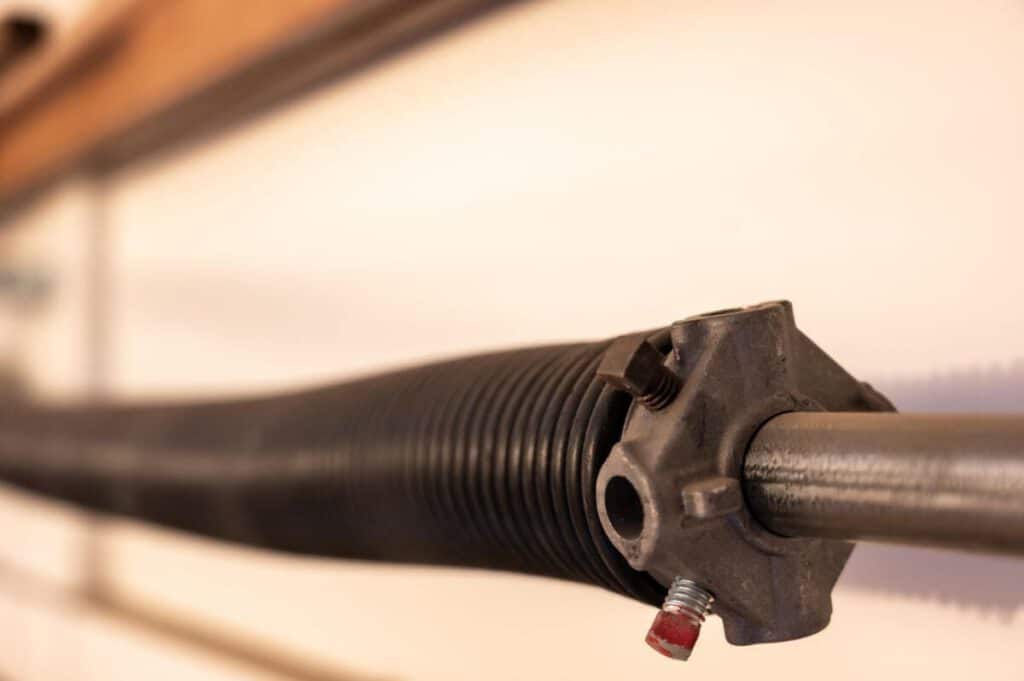Garage door springs are an essential component of your garage door system. They play a critical role in ensuring your garage door’s smooth and safe operation. The springs counterbalance the door’s weight, enabling it to open and close easily. With several types of garage door springs available in the market, it can be overwhelming to determine the right one for your garage door.
In this guide, we will discuss the importance of garage door springs, the different types of garage door springs, the spring color coding system, how to determine garage door spring size, garage door spring size by weight, how to choose the right garage door spring for your garage door, common scenarios to help you decide which garage door springs you need, garage door spring maintenance and safety, and when to replace garage door springs.
By the end of this guide, you will better understand garage door springs and be able to make an informed decision when selecting the correct springs for your garage door.
The Importance of Garage Door Springs
Garage door springs play a crucial role in the functionality of your garage door. They are responsible for counterbalancing the door’s weight, allowing it to open and close easily. Without garage door springs, the door would be tough to lift, and the opener would struggle to move the heavy door. Garage door springs also provide a safety mechanism, preventing the door from slamming shut in case of a malfunction or failure.
When garage door springs are in good working condition, they help extend the life of your garage door opener and other components by reducing the strain on the motor and other parts. However, when springs wear out or break, it can lead to dangerous situations and costly repairs. It is essential to choose the right type of garage door springs and maintain them properly to ensure your garage door’s safe and smooth operation.
Types of Garage Door Springs
There are two main types of garage door springs: torsion springs and extension springs. Each type has unique features, and it is crucial to understand their differences to make an informed decision when selecting the correct spring for your garage door.
Torsion springs
Torsion springs are the most common type of garage door springs. They are mounted horizontally above the garage door opening and use torque to balance the door’s weight. As the door closes, the torsion springs wind up and store energy. When the door is opened, the stored energy is released, helping to lift the door quickly.
Torsion springs are known for their durability and long lifespan. They are available in various sizes, making them suitable for various garage door weights and sizes. Torsion springs are also considered safer than extension springs, as they are contained within a shaft, reducing the risk of injury in case of a break.
Extension springs
Extension springs are mounted on either side of the garage door track and extend horizontally when the door is closed. These springs use the principle of extension and contraction to counterbalance the garage door’s weight. As the door closes, the extension springs are stretched, and when the door is opened, the springs contract, helping to lift the door.
Extension springs are typically used for lighter garage doors and are more affordable than torsion springs. However, they have a shorter lifespan and may require more frequent replacement. Extension springs also pose a higher risk of injury if they break, as they are not contained within a shaft like torsion springs.
The Spring Color Coding System: What You Should Know
The garage door industry has adopted a color coding system to help identify garage door springs’ different sizes and strengths. This system uses colored paint applied to the springs to indicate their weight capacity, wire size, and inside diameter. Understanding the color coding system can help you select the correct garage door springs for your needs.
The color code is usually found on the winding cone or the end of the spring. Remember that the color code is specific to the manufacturer, and it is essential to cross-reference the color with the manufacturer’s chart to determine the exact specifications of the spring.
It is also important to note that the color coding system is not standardized across all manufacturers, so it is crucial to consult the manufacturer’s documentation or a professional to ensure you choose the correct springs for your garage door.
How to Determine Garage Door Springs Size
Determining the correct size of the garage door spring is essential for your garage door’s proper functioning and safety. There are three critical measurements you need to consider when determining garage door spring size: wire size, inside diameter, and length.
- Wire size: The wire size refers to the thickness of the spring wire. A thicker wire will result in a stronger spring, while a thinner wire will result in a weaker spring. To measure the wire size, use a caliper or micrometer to measure the diameter of ten coils and divide the result by ten. This will give you the average wire diameter.
- Inside diameter: The inside diameter measures the spring’s interior opening. This critical measurement determines how the spring will fit on the torsion bar or extension spring mechanism. To measure the inside diameter, use a tape measure or ruler to measure the distance across the spring’s inner opening.
- Length: The length of the spring is another essential measurement, as it determines the overall strength and lifespan of the spring. Longer springs can typically handle more weight and last longer than shorter springs. To measure the length of a torsion spring, simply measure the length of the coils, excluding the winding cones. For extension springs, measure the size of the spring when it is fully extended.
By taking these measurements into account, you can determine the correct garage door spring size needed for your garage door.
Garage Door Spring Size by Weight
Another critical factor to consider when selecting garage door springs is the garage door’s weight. The springs must be able to counterbalance the importance of the door to ensure smooth and safe operation. To determine the weight of your garage door, you can use a garage door scale, which is available at most hardware stores or online.
When selecting garage door springs based on weight, you must also consider the number of cycles the spring is rated for. A cycle is defined as one complete garage door opening and closing. Springs with higher cycle ratings will typically last longer and perform better than those with lower cycle ratings.
To calculate the required spring size by weight, you can use the following formula:
Spring size = (Door weight / Number of springs) x (Door height / 2)
Using this formula, you can determine the appropriate spring size based on the weight of your garage door and ensure that the springs can effectively counterbalance the door.

How to Choose the right garage door spring for your garage door
Choosing the right garage door spring for your garage door involves considering several factors, including the type of spring, the spring’s size, and the door’s weight. Here are some steps to help you choose the right garage door spring:
- Determine the type of spring: First, decide whether you need a torsion spring or an extension spring. Torsion springs are more durable and safer, while extension springs are more affordable and suitable for lighter doors.
- Measure your garage door: Measure its height, width, and thickness to determine its size and weight. This information will be crucial in selecting the right spring size.
- Determine the spring size: Based on your measurements, use the formulas mentioned earlier to calculate the appropriate spring size for your garage door.
- Check the color coding system: Once you’ve determined the size of the spring, refer to the manufacturer’s color coding system to find the matching spring.
- Consult a professional: If you’re unsure which garage door spring suits your door, it’s always best to consult with a professional who can provide expert guidance and ensure you make the right choice.
Following these steps, you can choose the right garage door spring for your door and ensure its smooth and safe operation.
What garage door springs do I need? Common scenarios
Choosing the right garage door springs can be confusing, especially if you need clarification on your garage door’s type, size, or weight. To help you make the right decision, here are some common scenarios and the recommended garage door springs for each:
- Single garage door with a standard torsion spring system: For a standard single garage door (7 feet high and 8 to 9 feet wide), a single torsion spring with an inside diameter of 1 3/4 inches and a wire size of .225 should be sufficient.
- Double garage door with a standard torsion spring system: For a standard double garage door (7 feet high and 16 feet wide), a pair of torsion springs with an inside diameter of 2 inches and a wire size of .243 should be sufficient.
- Single garage door with an extension spring system: For a standard single garage door (7 feet high and 8 to 9 feet wide), a pair of extension springs with a 25-inch length and a 42-inch stretch should be sufficient.
- Double garage door with an extension spring system: For a standard double garage door (7 feet high and 16 feet wide), a pair of extension springs with a 27-inch length and a 48-inch stretch should be sufficient.
Remember that these recommendations are for standard garage door sizes and weights. If your garage door is custom-made or has unique specifications, it’s essential to consult with a professional to determine the appropriate garage door springs.
Garage door spring maintenance and safety
Maintaining your garage door springs is crucial to ensuring their safe and efficient operation. Here are some tips for maintaining your garage door springs:
- Inspect the springs regularly: Check for signs of wear or damage, such as cracks, rust, or loose coils. If you notice any issues, consult a professional for repair or replacement.
- Lubricate the springs: Apply a high-quality garage door lubricant to the springs at least twice a year to reduce friction and extend their lifespan.
- Test the door balance: With the garage door closed, disconnect the opener and manually lift the door halfway. If the door stays in place, the springs are properly balanced. If it falls or rises, the springs may need adjustment or replacement.
- Consult a professional: Garage door spring maintenance and repair should always be performed by a professional to ensure safety and proper functioning.
- Replace both springs: If one spring breaks or wears out, it’s a good idea to replace both springs, as the other one is likely nearing the end of its lifespan.
By following these maintenance and safety tips, you can help extend the life of your garage door springs and ensure the safe operation of your garage door.
When to replace garage door springs
Garage door springs have a limited lifespan and will eventually need to be replaced. Here are some signs that it’s time to replace your garage door springs:
- Age: Most garage door springs have a lifespan of 7 to 12 years, depending on their usage and maintenance. If your springs are older than this, it’s a good idea to consider a replacement.
- Broken or damaged springs: If you notice a broken or damaged spring, it’s essential to replace it immediately to prevent further damage to your garage door system.
- Difficulty opening or closing the door: If your garage door is difficult to open or close, it may be a sign that the springs are worn out or damaged.
- Sagging door: If your garage door sags or appears uneven when closed, it could indicate that the springs no longer provide adequate support.
- Loud noises: If you hear loud noises, such as banging or snapping, when operating your garage door, it may be a sign that the springs are damaged or need adjustment.
If you notice any of these signs, consult a professional garage door technician to determine if your springs need replacement.
Make the right choice for your garage door springs
Selecting the suitable garage door springs is crucial for your garage door’s safe and efficient operation. By understanding the different types of garage door springs, the color coding system, how to determine garage door spring size, and how to choose the right spring based on your garage door’s weight, you can make an informed decision when selecting garage door springs.
Remember to consult a professional if you are unsure which garage door spring is suitable for your door and to perform regular maintenance to ensure their safe and efficient operation. And when it’s time to replace your garage door springs, don’t hesitate to call a professional to handle the job.
At LMS Garage Door, we are your trusted partner for all your garage door needs. Our team of experienced technicians can help you choose the correct garage door springs and provide expert installation and maintenance services. Contact us today to learn how we can help you keep your garage door in top condition.



